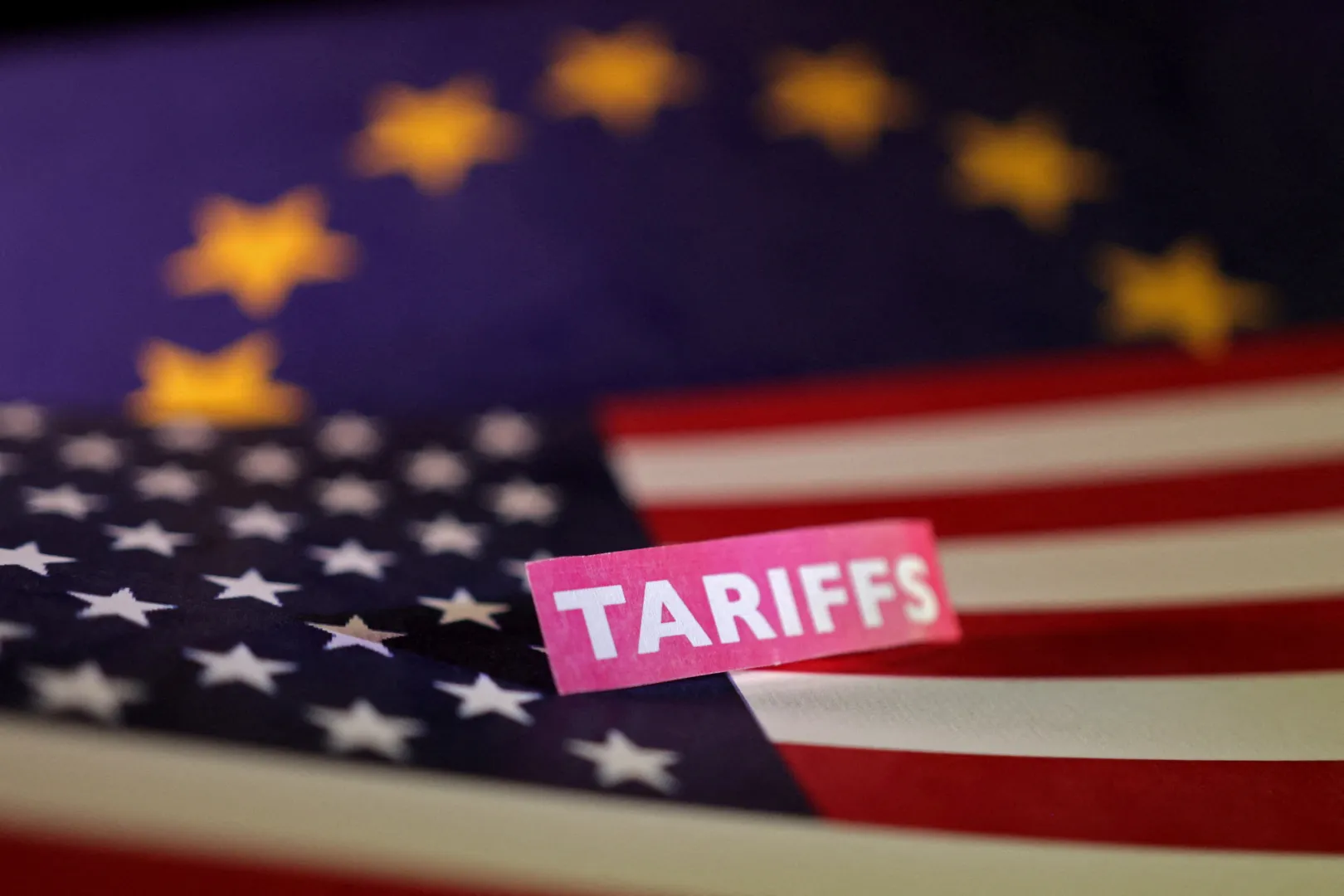Key Takeaway: The European Commission’s proposal to eliminate tariffs on US industrial goods represents a crucial step in implementing the historic July trade framework that avoided a devastating tariff war, but creates an asymmetric arrangement where Europe makes most concessions while facing continued challenges in key export sectors.
BRUSSELS – The European Commission proposed on Thursday removing duties on imported U.S. industrial goods in return for reduced U.S. tariffs on European cars, a key part of the trade agreement the EU and the United States struck last month.
The proposals mark the EU’s first step in enacting the framework agreement between U.S. President Donald Trump and Commission President Ursula von der Leyen on July 27, which saw the EU accept a broad 15% tariff to avoid a damaging trade war.
Build the future you deserve. Get started with our top-tier Online courses: ACCA, HESI A2, ATI TEAS 7, HESI EXIT, NCLEX-RN, NCLEX-PN, and Financial Literacy. Let Serrari Ed guide your path to success. Enroll today.
Automotive Industry Gets Crucial Relief
The United States agreed to reduce its tariffs on cars built in the European Union to 15% from 27.5% from the first day of the month in which the EU’s legislative proposal was presented – meaning now from August 1. This reduction provides significant relief to European automakers who have been grappling with escalating trade tensions and mounting costs.
The automotive tariff reduction comes as a lifeline for German manufacturers BMW, Mercedes-Benz, and Volkswagen, which had been subject to the higher 27.5% rate since April 2025. According to Bloomberg Intelligence, BMW and Mercedes stand to gain around €4 billion in earnings relief thanks to the new deal.
However, challenges remain substantial. The German Association of the Automotive Industry (VDA) warned that the 15% tariff will still cost German automotive companies billions annually, placing significant burden on manufacturers amid their transformation to electric vehicles.
Historic Deal Ends Months of Tense Negotiations
The agreement ended conflict between the world’s two largest trading and investment partners, although it represents an asymmetric deal, with Brussels required to cut its duties and buy more U.S. energy products while Washington retains tariffs on 70% of EU exports.
Trump has periodically railed against the European Union, saying in February that it was “formed to screw the United States” and has been critical of the U.S. merchandise trade deficit with the EU, which in 2024 amounted to $235 billion.
EU governments have broadly said they accept the deal as the lesser of evils, mindful that Trump was otherwise set to impose 30% tariffs on almost all imported EU goods. The threat had prompted the European Commission to prepare retaliatory measures on €93 billion worth of U.S. products.
Limited Impact on Industrial Goods
The impact of removing industrial goods tariffs may in fact be modest, with two-thirds already tariff-free. The average EU rate for U.S. goods is 1.35%, according to economic think tank Bruegel, although the EU does charge 10% for cars.
The EU proposals also include farm produce concessions, such as zero tariffs on potatoes, reduced rates for tomatoes and quotas with zero or low tariffs for pork, cocoa and pizza. It has excluded beef, poultry, rice and ethanol.
“We are protecting our defensive interests there. What we are giving are commitments that are certainly meaningful, but at the same time, I would observe that are not very costly for us today,” a Commission official said, adding that other G7 countries had already liberalised trade with the EU.
Complex Legislative Process Ahead
The EU’s legislative proposal will need to be approved by a majority of the EU’s 27 members and by the European Parliament, which could take several weeks. The process reflects the complex nature of EU decision-making, where member states must balance national interests with collective European benefits.
German Chancellor Friedrich Merz welcomed the agreement, stating it avoids “an unnecessary escalation in transatlantic trade relations” that would have severely impacted Germany’s export-oriented economy. However, he also criticized aspects of the deal, acknowledging it will cause “considerable damage” to both economies.
Italian Prime Minister Giorgia Meloni called the agreement “sustainable” and praised it for avoiding a “direct clash between the two sides of the Atlantic,” while Netherlands Prime Minister Dick Schoof acknowledged that “no tariffs would have been better” but praised securing the best agreement possible under the circumstances.
Massive Economic Commitments from EU
Beyond tariff adjustments, the deal includes unprecedented economic commitments from the European Union. The EU agreed to purchase $750 billion worth of U.S. energy products over three years and invest an additional $600 billion in various U.S. sectors by 2029.
These commitments represent a dramatic shift in transatlantic economic relations. Von der Leyen confirmed the EU would seek to buy an extra $250 billion of U.S. energy products annually from 2025 through 2027, fundamentally altering energy trade patterns between the regions.
However, questions remain about implementation mechanisms. The European Commission lacks authority to force private companies to purchase specific quantities of American products, making the achievement of these targets dependent on market conditions and commercial decisions.
Automotive Sector Faces Mixed Outlook
European automakers confront a complex new reality under the trade framework. While the reduction from 27.5% to 15% provides relief, it still represents a substantial increase from the pre-2024 rate of 2.5% on automobiles.
Mercedes-Benz, which directly employs about 11,100 people in the U.S., continues assessing the tariff impact while emphasizing its commitment to “constructive cooperation and policies that promote mutually beneficial trade.” The company’s Alabama plant, which exports roughly 60% of its 260,000 annual vehicle production to markets outside the U.S., benefits from the reduced tariff environment for exports.
BMW faces particular challenges, as the company relies heavily on European-sourced transmissions and engines, making it difficult to meet USMCA free-trade rules for production in Mexico or the U.S. The company’s South Carolina Spartanburg plant, which exported roughly 225,000 vehicles worth over $10 billion in 2024, now benefits from tariff relief on exports.
Volkswagen Group faces mixed exposure, with brands like Porsche and Audi lacking U.S. manufacturing facilities and remaining vulnerable to import tariffs, while VW brand products benefit from localized engine and transmission production for U.S. exports.
Broader Economic Context and Global Trade Impact
The agreement affects trading relationships accounting for almost a third of global trade. The U.S.-EU economic relationship represents the world’s largest bilateral trade and investment partnership, with two-way trade in goods and services reaching nearly $2 trillion in 2024.
Despite the deal’s completion, significant asymmetries remain. EU total goods trade with the United States reached $975.5 billion in 2024, with U.S. goods exports to the EU totaling $369.8 billion and imports reaching $605.7 billion, resulting in the substantial trade deficit that Trump has repeatedly criticized.
The services trade picture differs dramatically, with the EU running a €109 billion deficit in services trade with the U.S. in 2023, partially offsetting the goods trade imbalance that drives much of the political tension.
Strategic Exemptions and Continued Restrictions
Proponents of the deal recognize that increased U.S. tariffs remain, but point to a unique arrangement for the European Union whereby pre-existing U.S. duties, such as 2.5% for cars and up to 20% for cheeses, are not added to the broad 15% rate.
Some products, including aircraft, cork and generic drugs are exempt from the 15% tariff, reflecting strategic considerations and existing trade relationships. However, steel, aluminum and copper remain subject to punitive 50% tariffs, maintaining pressure on these critical industrial sectors.
The agreement includes “zero-for-zero tariffs” on aircraft and parts, semiconductor equipment, some farm goods and other “strategic products,” providing relief for high-technology sectors where both regions maintain competitive advantages.
Digital Services: The Unfinished Business
The agreement makes little mention of digital services, representing a significant gap in an increasingly important sector. However, Trump on Monday threatened additional tariffs on all countries with digital taxes or regulations, adding uncertainty to tech sector trade relations.
This omission becomes particularly significant given the EU’s ongoing efforts to regulate major U.S. technology companies through digital services legislation and competition policy. The lack of resolution on digital trade issues suggests continued friction in this rapidly growing sector.
Ready to level up your career? Join our expert-led Online courses in ACCA, HESI A2, ATI TEAS 7, HESI EXIT, NCLEX-RN, NCLEX-PN, and Financial Literacy. At Serrari Ed, we turn potential into achievement. Start your journey today!
Market Response and Industry Adaptation
Financial markets have responded with cautious optimism to the trade framework. European automotive stocks experienced initial gains following the July announcement, with the Stoxx Europe autos index rising 1.6% before reversing course as investors digested the ongoing challenges.
French car parts supplier Valeo traded 4.3% higher, with luxury Italian carmaker Ferrari up around 0.9%, while Germany’s BMW, Volkswagen and Mercedes-Benz Group remained down more than 1.3%, reflecting market uncertainty about long-term impacts.
Industry adaptation strategies vary significantly among manufacturers. Mercedes-Benz confirmed it is absorbing the tariff costs for its 2025 models, while BMW announced 4% price increases on certain models imported from Mexico, and other manufacturers contemplate shifting production to avoid tariff exposure.
Energy and Defense Trade Realignment
The deal’s energy provisions represent perhaps its most transformative aspect. The EU’s commitment to purchase an additional $750 billion in U.S. energy products over three years fundamentally alters transatlantic energy flows and could accelerate America’s position as a global energy exporter.
This energy purchasing commitment comes amid Europe’s continued efforts to diversify energy supplies and reduce dependence on traditional suppliers. The arrangement provides the U.S. with guaranteed European demand while offering Europe access to abundant American energy resources.
Additionally, the EU agreed to purchase military equipment worth “hundreds of billions of dollars,” reflecting growing defense cooperation amid global security challenges and Europe’s push to strengthen its defense capabilities in coordination with NATO commitments.
Regional Variations in Response
European member states have responded differently to the trade framework, reflecting varying economic interests and exposure to U.S. trade. Ireland’s Prime Minister Micheál Martin acknowledged the agreement “brings clarity and predictability” while noting it will make trade “more expensive and more challenging.”
France and Spain initially advocated stronger retaliation against Trump’s tariff threats, while Germany and Italy pushed for quick resolution to protect their export-oriented economies. This division highlighted the complexity of maintaining unified EU positions on trade policy when member states face different economic impacts.
The ideological gap among member states closed after Trump’s 30% tariff threat prompted widespread concern across the bloc and hardened sentiment toward potential retaliation, ultimately enabling von der Leyen to negotiate from a more unified position.
Implementation Challenges and Timeline
The EU’s legislative process for implementing the tariff eliminations faces several hurdles. Beyond requiring majority approval from all 27 member states, the proposals must navigate European Parliament scrutiny, where MEPs have called for continued transatlantic cooperation while expressing concerns about trade terms.
The complexity increases given that the original July framework represented a political agreement rather than a legally binding treaty. EU officials emphasized the preliminary nature of the agreement, noting that specific implementation details require further negotiation and legislative approval.
Meanwhile, the EU has delayed planned countermeasures against U.S. imports by six months to allow for continued negotiations, demonstrating European commitment to making the framework succeed despite its asymmetric nature.
Global Trade War Context
The EU deal represents one component of Trump’s broader trade strategy, following similar agreements with Japan (15% tariffs), the United Kingdom, Indonesia (19%), Vietnam (20%), and the Philippines (19%). A preliminary accord with China has also been reached, while dozens of countries face tariff implementation starting Friday.
This pattern reflects Trump’s “America First” trade philosophy, using tariff threats and negotiations to extract concessions from trading partners while generating revenue for the U.S. government. The approach represents a fundamental shift from the multilateral trade frameworks that have dominated global commerce for decades.
The success of the EU agreement may influence ongoing negotiations with other major trading partners, including Canada, Mexico, South Korea, and Brazil, all of whom face potential tariff implementation without successful deal completion.
Economic Analysis and Long-term Implications
Bloomberg Economics estimated that a no-deal outcome would have raised the effective U.S. tariff rate on European goods to nearly 18% on Friday. The new deal brings that number down to 16%, offering modest reprieve to European exporting firms while maintaining significantly higher barriers than historical norms.
According to Bruegel research, the average U.S. tariff rate on EU exports was just 1.5% at the end of 2024, highlighting the dramatic shift in trade relationships under the new framework.
The deal’s asymmetric nature raises concerns about European competitiveness in global markets. While avoiding the worst-case scenario of a full trade war, European companies now face higher costs accessing their largest export market, potentially affecting long-term investment and production decisions.
Sector-Specific Analysis
Pharmaceuticals: The 15% tariff on pharmaceutical products affects a crucial European export sector, potentially impacting patient access to medicines and raising healthcare costs in the United States.
Technology: Semiconductor equipment benefits from “zero-for-zero” arrangements, reflecting both regions’ recognition of the strategic importance of maintaining technology supply chains amid global competition with China.
Agriculture: The selective approach to agricultural products, with inclusions for potatoes and tomatoes but exclusions for beef and poultry, reflects sensitivity around European agricultural protectionism and American farming interests.
Steel and Aluminum: The maintenance of 50% tariffs on these sectors represents continued punishment for European metal producers and reflects Trump’s emphasis on protecting American heavy industry.
Financial Market Implications
The agreement creates new financial flows and market dynamics across the Atlantic. EU commitments to purchase American energy and invest in U.S. sectors require substantial capital deployment that could affect European capital markets and currency relationships.
The €600 billion investment commitment over Trump’s term represents approximately 4% of EU annual GDP, requiring significant mobilization of private and institutional capital. This scale of investment could influence European interest rates, currency stability, and available capital for domestic European projects.
Future Trade Relations
While the current agreement provides temporary stability, fundamental tensions in the transatlantic trade relationship remain unresolved. The lack of a comprehensive free trade agreement between the world’s two largest economies continues to create uncertainty for businesses planning long-term investments.
The failure to complete the Transatlantic Trade and Investment Partnership (TTIP) negotiations in 2016 left a vacuum that the current framework only partially addresses. Future negotiations will need to tackle digital services, regulatory alignment, and investment protection mechanisms to create lasting trade stability.
EU Trade Commissioner Maroš Šefčovič characterized the agreement as the “best deal we could get under very difficult circumstances,” suggesting European recognition of limited negotiating leverage in the face of American tariff threats.
Looking Ahead: Challenges and Opportunities
The success of the EU-U.S. trade framework will ultimately depend on effective implementation and continued political support on both sides of the Atlantic. European businesses must adapt to higher U.S. market access costs while capturing opportunities in energy and defense cooperation.
For the United States, the agreement provides additional government revenue through tariffs while securing European commitments for increased energy and defense purchases. However, higher import costs may contribute to inflationary pressures affecting American consumers.
The framework establishes a new baseline for transatlantic commerce that prioritizes American economic interests while maintaining essential trade links. Whether this model proves sustainable in the long term will depend on both regions’ ability to manage the economic adjustments and political pressures that higher trade barriers inevitably create.
As implementation proceeds over the coming months, businesses and policymakers on both sides will closely monitor economic impacts and adjust strategies accordingly. The agreement represents not just a trade deal, but a fundamental recalibration of the world’s most important economic relationship in an era of renewed trade nationalism.
Ready to take your career to the next level? Join our Online courses: ACCA, HESI A2, ATI TEAS 7 , HESI EXIT , NCLEX – RN and NCLEX – PN, Financial Literacy!🌟 Dive into a world of opportunities and empower yourself for success. Explore more at Serrari Ed and start your exciting journey today! ✨
Track GDP, Inflation and Central Bank rates for top African markets with Serrari’s comparator tool.
See today’s Treasury bonds and Money market funds movement across financial service providers in Kenya, using Serrari’s comparator tools.
Photo source: Google
By: Montel Kamau
Serrari Financial Analyst
29th August, 2025
Article, Financial and News Disclaimer
The Value of a Financial Advisor
While this article offers valuable insights, it is essential to recognize that personal finance can be highly complex and unique to each individual. A financial advisor provides professional expertise and personalized guidance to help you make well-informed decisions tailored to your specific circumstances and goals.
Beyond offering knowledge, a financial advisor serves as a trusted partner to help you stay disciplined, avoid common pitfalls, and remain focused on your long-term objectives. Their perspective and experience can complement your own efforts, enhancing your financial well-being and ensuring a more confident approach to managing your finances.
Disclaimer: This article is for informational purposes only and does not constitute financial advice. Readers are encouraged to consult a licensed financial advisor to obtain guidance specific to their financial situation.
Article and News Disclaimer
The information provided on www.serrarigroup.com is for general informational purposes only. While we strive to keep the information up to date and accurate, we make no representations or warranties of any kind, express or implied, about the completeness, accuracy, reliability, suitability, or availability with respect to the website or the information, products, services, or related graphics contained on the website for any purpose. Any reliance you place on such information is therefore strictly at your own risk.
www.serrarigroup.com is not responsible for any errors or omissions, or for the results obtained from the use of this information. All information on the website is provided on an as-is basis, with no guarantee of completeness, accuracy, timeliness, or of the results obtained from the use of this information, and without warranty of any kind, express or implied, including but not limited to warranties of performance, merchantability, and fitness for a particular purpose.
In no event will www.serrarigroup.com be liable to you or anyone else for any decision made or action taken in reliance on the information provided on the website or for any consequential, special, or similar damages, even if advised of the possibility of such damages.
The articles, news, and information presented on www.serrarigroup.com reflect the opinions of the respective authors and contributors and do not necessarily represent the views of the website or its management. Any views or opinions expressed are solely those of the individual authors and do not represent the website's views or opinions as a whole.
The content on www.serrarigroup.com may include links to external websites, which are provided for convenience and informational purposes only. We have no control over the nature, content, and availability of those sites. The inclusion of any links does not necessarily imply a recommendation or endorsement of the views expressed within them.
Every effort is made to keep the website up and running smoothly. However, www.serrarigroup.com takes no responsibility for, and will not be liable for, the website being temporarily unavailable due to technical issues beyond our control.
Please note that laws, regulations, and information can change rapidly, and we advise you to conduct further research and seek professional advice when necessary.
By using www.serrarigroup.com, you agree to this disclaimer and its terms. If you do not agree with this disclaimer, please do not use the website.
www.serrarigroup.com, reserves the right to update, modify, or remove any part of this disclaimer without prior notice. It is your responsibility to review this disclaimer periodically for changes.
Serrari Group 2025
















